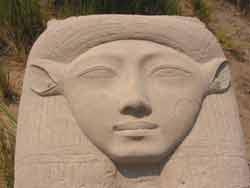
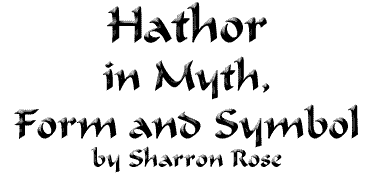
 |
I am the soul of Hathor |
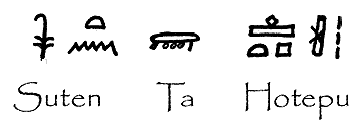 |
I am restored |
Hathor ( Het Heru in ancient Egyptian language), is the beautiful, nurturing cow-headed goddess of Egypt. She is the goddess of music, dancing, wine, joy, and love, whose devotees celebrate her rich generative powers through song, rhythm, and laughter. As the patron goddess of women and beauty, Hathor presides over the sacred feminine arts of adornment, enchantment, and lovemaking. In the temples of Egypt, images can still be seen of Hathor’s loving priestesses, their eyes ringed with kohl, their drums, lutes, tambourines, and sistrums infusing the psychic-energetic landscape with the abundant energy of her life-giving power.
In her divine role as the goddess of the cycles of life and fertility, Hathor is most associated with the sistrum, a musical instrument similar to a rattle with her face carved on its handle. In ancient times the bells on each of the four bars of the sistrum were tuned to the specific vibration of one of the four elements of nature, and playing the sistrum symbolized both Hathor’s generative powers and her ability to keep the world in harmony and balance. Plutarch, the first century Greek writer and initiate into the mysteries tells us of the vibratory power that playing of the sistrum generates in the warding off of evil influences.
 The sistrum also shows that existent things must be shaken up and never have cessation from impulse, but as it were be awakened up and agitated when they fall asleep and die away. For they say they turn aside and beat off Typhon (Set) with Sistra, signifying that when corruption binds nature fast and brings her to a stand, (then) generation frees her and raises her from death by means of motion"
The sistrum also shows that existent things must be shaken up and never have cessation from impulse, but as it were be awakened up and agitated when they fall asleep and die away. For they say they turn aside and beat off Typhon (Set) with Sistra, signifying that when corruption binds nature fast and brings her to a stand, (then) generation frees her and raises her from death by means of motion"
As an essential part of the rites of Hathor, her priestesses and devotees would drink wine, sing, and play their sistrums. Moving sensuously to the compelling beat of her vital rhythms, these worshippers would surrender themselves and become lost in the all-consuming bliss of her divine presence as it flowed within them. As these alternating rhythms of the cosmic goddess swelled and abated they generated states of ecstatic frenzy within the priestesses and devotees which brought them into resonance with her universal cycles of nature, of birth, growth, death and regeneration.
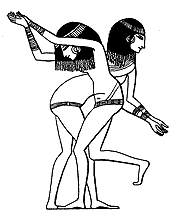 "Where there is lightness of spirit, a benevolent lubrication, then the ancient Egyptians would sense the closeness of Hathor. Celebrants became imbued with her spirit and we may surmise that the individual personality of the celebrant was lifted into a state of consciousness in which he or she felt possessed by the transpersonal energy of the Goddess."
"Where there is lightness of spirit, a benevolent lubrication, then the ancient Egyptians would sense the closeness of Hathor. Celebrants became imbued with her spirit and we may surmise that the individual personality of the celebrant was lifted into a state of consciousness in which he or she felt possessed by the transpersonal energy of the Goddess."
Jeremy Naydler, Temple of the Cosmos
As the ’beautiful one’, ‘ mistress of the vagina’, goddess of love, motherhood and female sexuality, Hathor is a quintessential Alchemical/Tantric Goddess whose priestesses were schooled in the sacred feminine arts of adornment and lovemaking. They are often shown holding a mirror with Hathor’s face carved on its handle. The mirror has many symbolic meanings. At first glance, it represents beauty, and the art of adornment. However, its meaning and usage go much deeper. It is both a tool for perceiving the inner working of the mind and a symbol for the act of self-observation. In ancient Egypt, it was used by the priestesses in magical practices for sending back negative energies to their source, as well as a medium for seeing through time, space and the more subtle dimensions of reality. While gazing into its depths, they would expand their awareness to journey from the earth to the stars and from the outer material form to the inner spiritual essence.
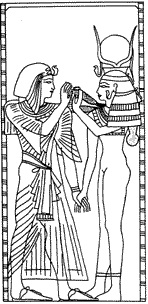 | Another of Hathor’s primary symbolic implements is the menat necklace. Like the sistrum, it was used as a percussion instrument but also as a medium through which her divine power and energy was transmitted. Oftentimes she is depicted offering the menat to the pharaoh, through which she transmits her life-enhancing gifts of feminine power, grace and divine energy.
|
In many paintings, Hathor, like the Great Goddess Isis is crowned with the risen serpent, symbol of the awakened kundalini, visionary capacity and wisdom; the horns of sacred cow signifying the crescent moon, the chalice and the boat in which the goddess ferries souls across the ocean of existence; and the sun, symbol of essence, source, warmth, heat, vitality, energy, vibration, excitation, power, and expansion.
 |
Hathor, womb of the origin |
Her essential hieroglyph, read as Het Heru, which translates as the house of Horus symbolizes Hathor in her ancient role as sky goddess. Here she is seen as, the primeval waters or womb of space where the great illuminated one Horus, the oldest of the sun gods, represented here by the falcon was conceived, brought forth and dwelled
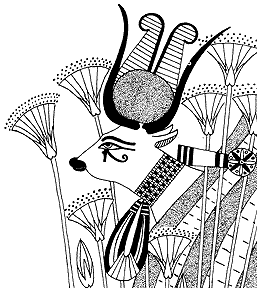 In her form as the celestial cow that nourishes all creation, Hathor is an ancient goddess who originates from predynastic Egypt. Pictured in this form with stars on her belly, horns of the crescent moon and a solar disk on her head, Hathor, the ‘mother of the light’ and ‘golden one’, is the loving consort of the powerful sun god Ra. Throughout the literature she is alternatively referred to as Ra’s mother, daughter, and powerful shining eye. According to the eminent scholar of Egyptian studies E. A. Wallis Budge, Hathor was perceived as "the great Mother of the World," and the "power of nature that was perpetually conceiving and bringing forth, rearing and maintaining all things, both great and small." In this role she represented the fullness of the feminine experience. "She was the mother of her father, and the daughter of her son. Heaven, earth and the underworld were under her rule and she was the mother of every god and every Goddess."
In her form as the celestial cow that nourishes all creation, Hathor is an ancient goddess who originates from predynastic Egypt. Pictured in this form with stars on her belly, horns of the crescent moon and a solar disk on her head, Hathor, the ‘mother of the light’ and ‘golden one’, is the loving consort of the powerful sun god Ra. Throughout the literature she is alternatively referred to as Ra’s mother, daughter, and powerful shining eye. According to the eminent scholar of Egyptian studies E. A. Wallis Budge, Hathor was perceived as "the great Mother of the World," and the "power of nature that was perpetually conceiving and bringing forth, rearing and maintaining all things, both great and small." In this role she represented the fullness of the feminine experience. "She was the mother of her father, and the daughter of her son. Heaven, earth and the underworld were under her rule and she was the mother of every god and every Goddess."
In her form as the celestial cow Hathor plays a significant role in the Papyrus of Ani, the Book of Coming Forth by Day, known to us as the Egyptian Book of the Dead, which was written around 1250 b.c.e. Hathor, as the lady of the underworld, is present to receive the deceased, feed and care for them, watch over them, and assist them in their journey toward illumination. She is present at the critical moment of judgment when the heart of the dead is weighed for its purity, and she brings delight and blessings to those whose hearts have been found pure. In the concluding scene of the Book of the Dead, Hathor emerges from the marshes into the light of everlasting life, in conjunction with an epithet:
"Hathor, Lady of the West; She of the West; Lady of the Sacred Land; Eye of Re which is on his forehead; Kindly of countenance in the Bark of Millions of Years; A resting-place for him who has done right with the boat of the blessed; Who built the Great Bark of Osiris in order to cross the Water of Truth."
Transformation into Hathor brings great feelings of joyousness, eroticism and ecstasy into our lives. Not only does she show us the way of truth and beauty, but provides a role model for the most superb qualities of woman in her roles as mother, wife, daughter and teacher. Revitalized and restored by her powerful life-enhancing energy we begin to open ourselves to the sacred feminine arts of adornment, music, dance and lovemaking. As we feel her sacred rhythms of life flowing within the temple of our physical bodies, an air of mystery begins to surround us. We gain the ability to magnetize and bring into our lives the people and circumstances that will lead us to new experiences of the rich, creative power of the divine feminine spirit.
~Sharron Rose
Hieroglyphs and prayers from the Book of the Dead
courtesy of Egyptian scholar John Nichols



 The hieroglyph of the menat necklace clearly demonstrates Hathor’s tantric aspect as this sacred energy is depicted pouring into and flowing between the representation of a phallic-like symbol representing the masculine and the crescent moon or chalice, symbol of the feminine.
The hieroglyph of the menat necklace clearly demonstrates Hathor’s tantric aspect as this sacred energy is depicted pouring into and flowing between the representation of a phallic-like symbol representing the masculine and the crescent moon or chalice, symbol of the feminine.





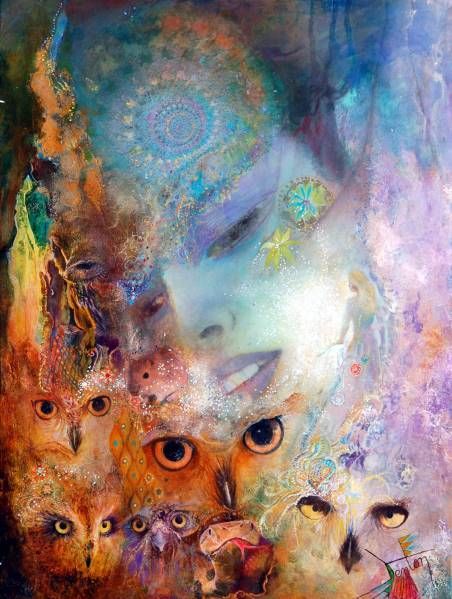

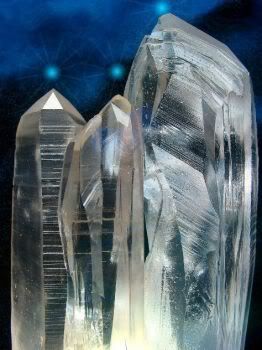

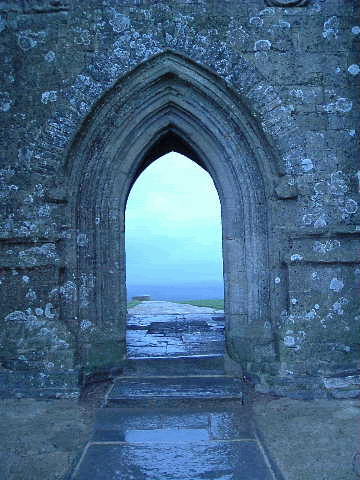


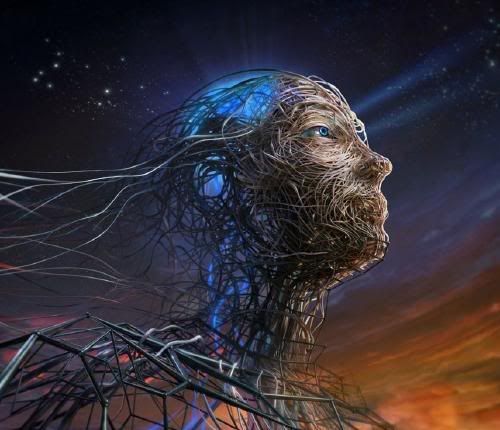

No comments:
Post a Comment